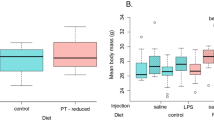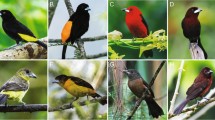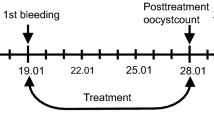Abstract
BROWN Leghorn fowl show a strong sexual dimorphism in the plumage pigmentation, the female colouring being developed only in presence of the ovary whereas the male shades characterize intact or castrate bird alike. All feather tracts differ in some respects between the sexes ; the present discussion centres on the pectoral (breast) region which is salmon in the hen and black in the cock. In early studies of hormonal mechanisms in birds, Brown Leghorn cocks or capons with enforced feather regeneration were injected with an extract of human placentae, the preparation having been tested on the pullet oviduct for avian cestrogenic properties1. With this procedure the treated males developed a salmon female breast feathering which was indistinguishable in colour from that of the corresponding area in the normal hen. In later experiments synthetic œstrogens were employed, and here, it appeared, a pigmentation was produced resembling, but clearly darker than, the usual female. This shade was variously thought a matter of dosage2 ; a matter of dosage but transitory3 ; and as indicative of a genetic difference in the test fowl4. The last interpretation is not discounted, but it will be shown that two distinctly different modified breast feather pigments may follow from one single course of diethylstilboestrol treatment in one and the same Brown Leghorn capon. This is so because of the range of dosage requirements for feminization of the male breast feather tracts, the increase occurring in antero-posterior direction5. In favourable material, modified bars resembling the true female salmon were found in association with bars of a darker shade in feathers of more posterior location. This ‘darker’ shade, however, appeared more akin to the red which invades the breast tracts after thyroidectomy and which corresponds more closely with the red of the normal male saddle feather6. It seemed possible, therefore, that at certain levels the synthetic œstrogen produced effects comparable to thyroidectomy and that the darker pigmentation was in fact similar to if not identical with this male red. The foregoing inferences are now confirmed by Spectrophotometric differentiation of the normal female salmon from the normal red male and identification of each of these with modified breast feathers of the same capon following short-term œstrogen treatment.
This is a preview of subscription content, access via your institution
Access options
Subscribe to this journal
Receive 51 print issues and online access
$199.00 per year
only $3.90 per issue
Buy this article
- Purchase on Springer Link
- Instant access to full article PDF
Prices may be subject to local taxes which are calculated during checkout
Similar content being viewed by others
References
Juhn, M., and Gustavson, R. G., J. Exp. Zool., 56, 31 (1930).
Wang, H., J. Exp. Zool., 109, 451 (1948).
Caridroit, F., and Regnier, V., Sixth World's Poultry Cong., Section 3, 12 (1936).
Trinkaus, J. P., Proc. Third Conf. Biology of Normal and Atypical Pigment Cell Growth, 73 (Academic Press, New York, 1953).
Juhn, M., Faulkner, G. H., and Gustavson, R. G., J. Exp. Zool., 58, 69 (1931).
Greenwood, A. W., and Blyth, J. S. S., Proc. Roy. Soc. Edin., 49, 313 (1929).
Greenewalt, C. H., Brandt, W., and Friel, D. D., J. Opt. Soc. Amer., 50, 1005 (1960).
Author information
Authors and Affiliations
Rights and permissions
About this article
Cite this article
JUHN, M. Spectrophotometric Identification of Feather Pigments in the Brown Leghorn Fowl. Nature 202, 507–508 (1964). https://doi.org/10.1038/202507a0
Issue Date:
DOI: https://doi.org/10.1038/202507a0
This article is cited by
-
Demonstration of virus particles in ovine pulmonary adenomata
Experientia (1971)
Comments
By submitting a comment you agree to abide by our Terms and Community Guidelines. If you find something abusive or that does not comply with our terms or guidelines please flag it as inappropriate.



